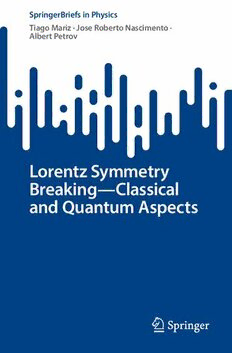
Lorentz Symmetry Breaking―Classical and Quantum Aspects PDF
Preview Lorentz Symmetry Breaking―Classical and Quantum Aspects
SpringerBriefs in Physics Tiago Mariz · Jose Roberto Nascimento · Albert Petrov Lorentz Symmetry Breaking—Classical and Quantum Aspects SpringerBriefs in Physics SeriesEditors BalasubramanianAnanthanarayan,CentreforHighEnergyPhysics,Indian InstituteofScience,Bangalore,Karnataka,India EgorBabaev,DepartmentofPhysics,RoyalInstituteofTechnology,Stockholm, Sweden MalcolmBremer,H.H.WillsPhysicsLaboratory,UniversityofBristol,Bristol, UK XavierCalmet,DepartmentofPhysicsandAstronomy,UniversityofSussex, Brighton,UK FrancescaDiLodovico,DepartmentofPhysics,QueenMaryUniversityof London,London,UK PabloD.Esquinazi,InstituteforExperimentalPhysicsII,UniversityofLeipzig, Leipzig,Germany MaartenHoogerland,UniversityofAuckland,Auckland,NewZealand EricLeRu,SchoolofChemicalandPhysicalSciences,VictoriaUniversityof Wellington,Kelburn,Wellington,NewZealand DarioNarducci,UniversityofMilano-Bicocca,Milan,Italy JamesOverduin,TowsonUniversity,Towson,MD,USA VesselinPetkov,Montreal,QC,Canada StefanTheisen,Max-Planck-InstitutfürGravitationsphysik,Golm,Germany CharlesH.T.Wang,DepartmentofPhysics,UniversityofAberdeen,Aberdeen,UK JamesD.Wells,DepartmentofPhysics,UniversityofMichigan,AnnArbor,MI, USA AndrewWhitaker,DepartmentofPhysicsandAstronomy,Queen’sUniversity Belfast,Belfast,UK SpringerBriefsinPhysicsareaseriesofslimhigh-qualitypublicationsencompassing the entire spectrum of physics. Manuscripts for SpringerBriefs in Physics will be evaluatedbySpringerandbymembersoftheEditorialBoard.Proposalsandother communicationshouldbesenttoyourPublishingEditorsatSpringer. Featuring compact volumes of 50 to 125 pages (approximately 20,000–45,000 words),Briefsareshorterthanaconventionalbookbutlongerthanajournalarticle. Thus,Briefsserveastimely,concisetoolsforstudents,researchers,andprofessionals. Typicaltextsforpublicationmightinclude: (cid:129) Asnapshotreviewofthecurrentstateofahotoremergingfield (cid:129) Aconciseintroductiontocoreconceptsthatstudentsmustunderstandinorderto makeindependentcontributions (cid:129) Anextendedresearchreportgivingmoredetailsanddiscussionthanispossible inaconventionaljournalarticle (cid:129) Amanualdescribingunderlyingprinciplesandbestpracticesforanexperimental technique (cid:129) An essay exploring new ideas within physics, related philosophical issues, or broadertopicssuchasscienceandsociety Briefsallowauthorstopresenttheirideasandreaderstoabsorbthemwithminimal time investment. Briefs will be published as part of Springer’s eBook collection, withmillionsofusersworldwide.Inaddition,theywillbeavailable,justlikeother books, for individual print and electronic purchase. Briefs are characterized by fast,globalelectronicdissemination,straightforwardpublishingagreements,easy- to-usemanuscriptpreparationandformattingguidelines,andexpeditedproduction schedules.Weaimforpublication8–12weeksafteracceptance. · · Tiago Mariz Jose Roberto Nascimento Albert Petrov Lorentz Symmetry Breaking—Classical and Quantum Aspects TiagoMariz JoseRobertoNascimento InstitutodeFísica DepartamentodeFísica UniversidadeFederaldeAlagoas UniversidadeFederaldaParaíba Maceió,Alagoas,Brazil JoãoPessoa,Paraíba,Brazil AlbertPetrov DepartamentodeFísica UniversidadeFederaldaParaíba JoãoPessoa,Paraíba,Brazil ISSN 2191-5423 ISSN 2191-5431 (electronic) SpringerBriefsinPhysics ISBN 978-3-031-20119-6 ISBN 978-3-031-20120-2 (eBook) https://doi.org/10.1007/978-3-031-20120-2 ©TheAuthor(s),underexclusivelicensetoSpringerNatureSwitzerlandAG2022 Thisworkissubjecttocopyright.AllrightsaresolelyandexclusivelylicensedbythePublisher,whether thewholeorpartofthematerialisconcerned,specificallytherightsoftranslation,reprinting,reuse ofillustrations,recitation,broadcasting,reproductiononmicrofilmsorinanyotherphysicalway,and transmissionorinformationstorageandretrieval,electronicadaptation,computersoftware,orbysimilar ordissimilarmethodologynowknownorhereafterdeveloped. Theuseofgeneraldescriptivenames,registerednames,trademarks,servicemarks,etc.inthispublication doesnotimply,evenintheabsenceofaspecificstatement,thatsuchnamesareexemptfromtherelevant protectivelawsandregulationsandthereforefreeforgeneraluse. Thepublisher,theauthors,andtheeditorsaresafetoassumethattheadviceandinformationinthisbook arebelievedtobetrueandaccurateatthedateofpublication.Neitherthepublishernortheauthorsor theeditorsgiveawarranty,expressedorimplied,withrespecttothematerialcontainedhereinorforany errorsoromissionsthatmayhavebeenmade.Thepublisherremainsneutralwithregardtojurisdictional claimsinpublishedmapsandinstitutionalaffiliations. ThisSpringerimprintispublishedbytheregisteredcompanySpringerNatureSwitzerlandAG Theregisteredcompanyaddressis:Gewerbestrasse11,6330Cham,Switzerland Preface In this book, we review various aspects of the Lorentz symmetry breaking, both classical and quantum ones, with the special interest to perturbative generation of Lorentz-breakingterms.WepresentimpactsofLorentzsymmetrybreakinginnon- commutativeandsupersymmetrictheories.Also,wediscusstheproblemofLorentz symmetry breaking in a curved space-time. The book is closed with a review of experimentalstudiesofLorentzsymmetrybreaking. Authors are grateful to J. F. Assunção, A. P. Baeta Scarpelli, H. Belich, L.H.C.Borges,F.A.Brito,L.C.T.Brito,M.Cvetic,A.G.Dias,J.C.C.Felipe, A. F. Ferrari, C. Furtado, J. Furtado, M. S. Guimaraes, H. O. Girotti, M. Gomes, A. C. Lehum, R. V. Maluf, C. Marat Reyes, E. Passos, P. Porfirio, A. A. Ribeiro, R.F.Ribeiro,V.O.Rivelles,A.F.Santos,M.Schreck,A.J.daSilva,A.R.Vieira, C.WotzasekandC.A.D.Zarro,forfruitfulcollaborationandinterestingdiscussions. TheworkhasbeenpartiallysupportedbyCNPq. Maceió,Brazil TiagoMariz JoãoPessoa,Brazil JoseRobertoNascimento JoãoPessoa,Brazil AlbertPetrov v Contents 1 Introduction ................................................... 1 References ..................................................... 4 2 ClassicalAspectsoftheLorentzSymmetryBreaking .............. 7 2.1 ReviewofMostImportantLVExtensionsofFieldTheory Models ................................................... 7 2.2 WavePropagationinLVTheories ............................. 11 2.3 DualityIssuesinLVTheories ................................ 13 2.4 SpontaneousBreakingofLorentzSymmetry ................... 16 2.5 Conclusions ............................................... 21 References ..................................................... 22 3 PerturbativeGenerationofLVTerms ............................ 25 3.1 ProblemofAmbiguities ..................................... 25 3.2 LVContributionsintheScalarSector ......................... 28 3.3 MixedLVScalar-VectorContribution ......................... 30 3.4 TheCarroll-Field-JackiwTerm ............................... 34 3.4.1 GeneralSituationandZeroTemperatureCase ............ 34 3.4.2 FiniteTemperatureCase .............................. 40 3.4.3 Non-abelianGeneralization ............................ 41 3.5 CPT-EvenTermfortheGaugeField ........................... 43 3.6 Higher-DerivativeLVTerms ................................. 48 3.7 DivergentContributionsinGaugeandSpinorSectorsofLV QED ...................................................... 51 3.8 DiscussionandConclusions .................................. 53 References ..................................................... 54 4 Lorentz Symmetry Breaking and Space-Time Noncommutativity ............................................. 57 4.1 FormulationsforNoncommutativity ........................... 58 4.2 LVImpactsoftheMoyalProduct ............................. 59 4.3 Seiberg-WittenMap ........................................ 62 vii viii Contents 4.4 NoncommutativeFields ..................................... 64 4.5 Conclusions ............................................... 67 References ..................................................... 68 5 LorentzSymmetryBreakingandSupersymmetry ................. 71 5.1 DeformationoftheSupersymmetryAlgebra .................... 72 5.2 LorentzSymmetry Breaking Through Introducing Extra Superfields ................................................ 77 5.3 StraightforwardLorentzSymmetryBreakinginaSuperfield Action .................................................... 79 5.4 Conclusions ............................................... 82 References ..................................................... 83 6 LorentzandCPTSymmetryBreakinginGravity ................. 85 6.1 Motivationsfor4DGravitationalChern-SimonsTerm ........... 86 6.2 PerturbativeGenerationoftheGravitationalCSTerm ............ 88 6.3 Problem of Spontaneous Lorentz Symmetry Breaking inGravity ................................................. 93 6.4 PossibleLVTermsinGravity ................................ 95 6.5 Conclusions ............................................... 97 References ..................................................... 99 7 ExperimentalStudiesoftheLorentzSymmetryBreaking .......... 101 7.1 Non-gravitationalStudies .................................... 102 7.2 GravitationalEffects ........................................ 104 References ..................................................... 106 Index ............................................................. 109 Chapter 1 Introduction TheLorentzsymmetry,beingcertainlyoneofthemostimportantsymmetriesofthe quantumfieldtheory,naturallyrequiresdetailedstudies.Oneofthemostimportant relatedissuesisthedeterminationofitslimitsofapplicability.Whilevalidityofthis symmetrycontinuestobeverifiedwithahighdegreeofprecision[1],someprofound theoreticalmotivationsforitsbreakingmustbediscussed.Alreadyin1989,in[2], ithasbeensupposedthat,inthelow-energylimitofthebosonicstring,somevector, or,ingeneral,tensorfieldscanacquirenon-zeroexpectationvalues,which,intheir turn,introducesomeprivilegeddirectionsinthespace-time,and,therefore,breakthe Lorentzsymmetry.Asanextstep,thefirstLorentz-violating(LV)generalizationof aknownfieldtheorymodelwasproposed,thatis,themodificationoftheusualfour- dimensional QED by the following additive term called the Carroll-Field-Jackiw (CFJ)term[3]: LCFJ =(cid:2)αβγδkαAβ∂γAδ. (1.1) Here,thekα isaconstantvector,whosecomponentsareassumedtobesmall,intro- ducingtheanisotropyinthespace-timeandthusbreakingtheLorentzsymmetry.1 Thistermcanbetreatedasanaturalfour-dimensionalextensionofthewell-known Chern-Simons term, being gauge invariant up to a total derivative. Evidently, the introduction of the CFJ term called an interest to investigation of its implications both at the classical level, especially dispersion relations and issues related with unitarity and causality, and at the quantum level, that is, possibilities for its per- turbativegeneration,studiesofrenormalizationandrenormalizability,relationwith possible anomalies, etc., and some important results obtained within these studies arereviewedinthisbook.Further,otherLVextensionshavebeenproposed,notonly 1WithinthisbookwediscussonlysmallLVmodificationsofknownfieldtheorymodelsanddonot addressthetheoriescharacterizedbystrongspace-timeasymmetryliketheHorava-Lifshitz-like ones[4]. ©TheAuthor(s),underexclusivelicensetoSpringerNatureSwitzerlandAG2022 1 T.Marizetal.,LorentzSymmetryBreaking—ClassicalandQuantumAspects, SpringerBriefsinPhysics,https://doi.org/10.1007/978-3-031-20120-2_1 2 1 Introduction fortheelectromagneticfield,butforspinorandscalaronesaswell,whichallowedto formulatetheLVstandardmodelextension(LVSME)[5,6],makingthusaLorentz symmetrybreakingtobeanexperimentallytestablephenomenon.Itisimportantto sayherethattheCFJtermbreakstheCPTsymmetryaswell,duetothepresenceof theconstantvector.Ingeneral,theLVtermsinvolvingconstanttensorsofoddranks breakalsotheCPTsymmetry,whilethepresenceofconstanttensorsofevenranks maintainstheCPTinvariance,seee.g.[7]. Clearly, it is necessary here to discuss the reasons allowing for the applicabil- ity of the usual relativistic formalism within LV theories. Really, in a LV theory there can be two types of Lorentz transformations [5, 6, 8, 9]: the observer ones and the particle ones. The background fields, that is, just those ones represented by constant vectors or tensors, transform under the observer Lorentz transforma- tionsbutnotundertheparticleLorentztransformations,whilethedynamicalfields transformbothunderobserverandparticleLorentztransformations.Therefore,the Lagrangians of LV theories continue to be invariant under observer Lorentz trans- formationsbutnotinvariantunderparticleLorentztransformations(thelastonesare sometimesalsodenominatedasactiveLorentztransformations)[5, 6].Thisallows toapplytherelativisticmethodologywithintheframeworkoftheobserverLorentz transformations. Besides of the string theory, there are other reasons for the Lorentz symmetry breaking.Themostimportantofthemare,first,thepossiblevariabilityofthefunda- mentalconstants,especially,thespeedoflight,whichbegantobediscussedinorder toexplainthecosmicacceleration(seee.g.[10]),second,thespace-timenoncommu- tativity,whichinthemostused,Moyal-typeversioninvolvesaconstantsecond-rank antisymmetrictensor(cid:8)μν,whichclearlyisnotLorentz-invariant[11],third,theloop quantumgravityproposedasanattempttoquantizethegeometry(seeforareview [12]), fourth, the concept of the space-time foam originally proposed in [13] and further discussed, e.g., in [14, 15] (three last scenarios evidently require existence ofsomeminimaldistancescale),and,probably,otherreasons. The main implications of the LV extensions of field theory models, especially, oftheelectrodynamics,atthetreelevelconsistinnontrivialbehaviorofthepossi- bleclassicalsolutions,whichcandisplayinavacuumthephenomenacharacteristic forpropagationofelectromagneticwavesinnontrivialmedia,suchasbirefringence [16,17]androtationofthepolarizationplane[16],whichcanallowtouseLVmod- elsforaneffectivedescriptionforvariouscondensedmatterphenomenaincluding, e.g.,superconductivity,magneticconductivity,Bose-Einsteincondensationandother effects,someexamplesofsuchstudiesaregivenin[18–22].Besidesofthis,oneof theimportantissuesatthetreelevelisalsorelatedwiththeproblemsofunitarityand causality,which,ingeneral,arenotguaranteedforLVtheories,sothat,typically,to achieveunitarityandcausality,theLVparametersshouldsatisfyspecialconditions whichvaryfordifferenttheories,seee.g.[23–25].However,itturnsouttobethat formanyexamplesoftheLVtheoriesneitherunitaritynorcausalityarebrokenfor somecharacteristic,usuallysmall,valuesofLVparameters. Attheperturbativelevel,themainideaconsistsinapossibilitytogeneratecertain LVadditivetermswhichcanbeemployedwithinextensionsofknownfieldtheory
